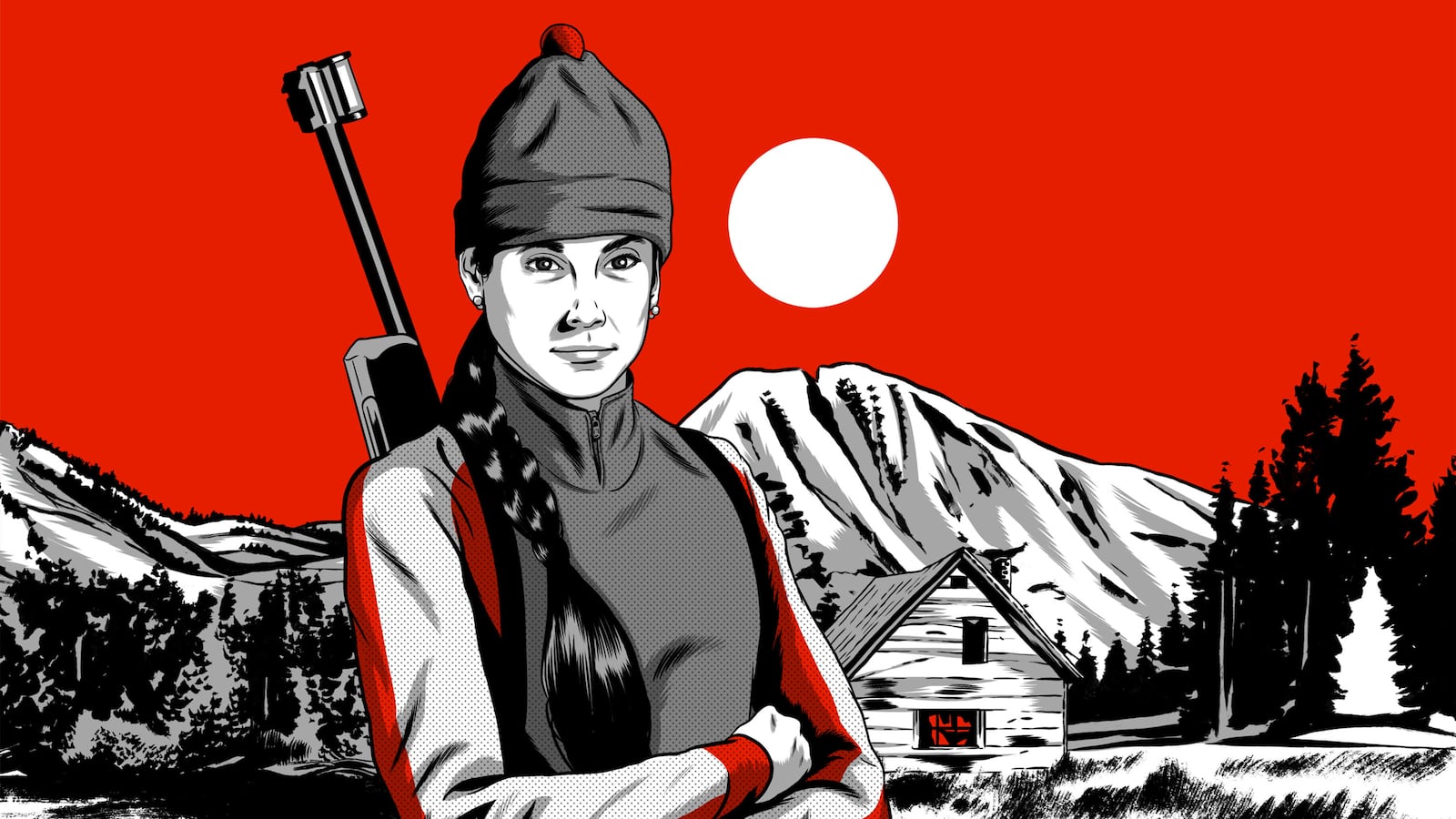There’s no particular news peg that might bring someone to revisit the harrowing, 36-year-old story of Kari Swenson, a world champion athlete whose career was cut short in 1984 when she was abducted by a deranged father and son in the mountains of Montana, tied to a tree, and shot, as her friend died trying to save her. But the new season of ESPN’s “30 for 30” project, which will drop four audio documentaries in the next few weeks including one about Swenson titled Out of the Woods, is very much about the news, about how the cycle can make myth out of tragedy, and at times, obscure those at the center of it.
If you were alive in 1984, Swenson’s story may be familiar. The 22-year-old from Montana, who wore her long, brown hair in an exacting middle part, rose to national attention in the 1980s as an unusual kind of athlete. She competed in biathlons, a kind of winter race which combines cross-country skiing and shooting targets with a small-bore rifle. It’s an esoteric sport, dating back to Nordic military exercises in the 18th century, and all the more unusual for Swenson, one of only a few female or American competitors. In 1980, Swenson was recruited for the first U.S. women’s program, alongside two athletes named Holly Beattie and Julie Newnam, with whom she would later break records. Four years later, the trio won a bronze medal at the first women’s Biathlon World Championships—a first for the U.S. in a sport usually dominated by Europe—and Swenson placed fifth overall in the women’s 10 kilometer race, making her the best ranked American biathlete, of either sex, in nearly three decades of international competition.
But just four months after her victory, Swenson’s good fortune soured. On July 15, 1984, the biathlete left for a run on a logging road near the Big Sky resort in Bozeman. At a turn in the trail, she came upon two men, both dirty and unshaven, both sporting wide-brimmed hats, both toting rifles. Law enforcement later identified the men as Don Nichols, 53, and his 19-year-old son, named, impossibly, Dan. The two had spent a good part of the past 12 years living on the mountain range in makeshift camps. Years earlier, as court testimony would later reveal, Don had purchased a large chain in order to “secure” a wife sometime in the future. Seeing Swenson, the men grabbed her by the wrists, carted her to their latest site, wrapped her in a sleeping bag, and chained her to a pine tree.
By nightfall, Swenson’s disappearance had been noticed, and her family planned search parties. Volunteers split off in twos to scout along the woods. One pair involved 30-year-old Jim Schwalbe, a landscaper from Wisconsin, and Alan Goldstein, a 36-year-old retailer-turned-rancher. While stumbling through the woods to a nearby road around 7:30 a.m., the two got separated. Then Schwalbe heard a gunshot, a scream, and three voices, one female, two male. He broke through to the camp and found two men standing above Swenson, who was bleeding from the chest. The four stood in shock. The younger Nichols was nearly crying, Schwalbe recalled in a 1985 Sports Illustrated article, repeating something about how he hadn’t meant to hit her. The older Nichols pointed his rifle at Schwalbe, when Goldstein arrived on site and tried to intervene. Don Nichols fired, hitting Goldstein in the face, as Schwalbe sprinted away. The Nichols packed up their camp, unchained Swenson, and abandoned her to bleed out. Swenson lay on the ground for four hours. She crawled into a nearby sleeping bag, nibbled at a chocolate bar, swigged from a lemonade, and tried not to pass out. A helicopter found her at 11:55 a.m.
Once at the hospital, Swenson stabilized. But the aftermath proved nightmarish. For months, the Nichols evaded capture and the manhunt became a regular feature on the news. When a local sheriff finally caught the kidnappers, he wrote a book about it, which was adapted as a TV movie (The Abduction of Kari Swenson) just three years later. Everyone had a theory about the Nichols, about their “nonconformist philosophy,” about what had driven them into the mountains, and then, to abduction. The “Nichols Boys” were branded “survivalists” and “mountain men.” Barbara Walters called their lifestyle “almost romantic.” Esquire painted them as “some rowdy mountain men [trying] to snag a wife.” When Don and Dan went to trial in Virginia City, Montana, tourists asked for their autographs. When the son was sentenced to 10 years in prison and the father to 85, news segments conducted jailhouse interviews and published their letters from jail. From the headlines, it was easy to conclude the Nichols were rugged outlaws, frontiersmen who did what they wanted, took what they could, and made no apologies. By contrast, Swenson, a world class athlete and trained sharpshooter, found herself described in one outlet as “a proper Belle of Bozeman, the perfect flower of the New West.”
Swenson rarely spoke to media. She went on to become a small animal veterinarian and largely left public life. But the athlete’s distaste for the rendering of her story came out in 1989, when her mother published a book called Victims: The Kari Swenson Story, which retold the abduction from Swenson’s view of things, and in sparse interviews and articles over the years. In 2012, after Dan had been released from prison, rearrested on drug charges, and targeted by a federal arrest warrant after ditching his trial, Swenson wrote an article for The Montana Pioneer mocking their moniker “Mountain Men” and warning against Don’s possible parole. “The Nichols lived in the mountains part-time but they couldn’t survive there,” Swenson wrote, “at least not without poaching, breaking into cabins and stealing supplies, leaving the mountains for months at a time and purchasing modern equipment. Ultimately they were caught without a fight because they were cold, hungry, and tired of living in the mountains. These are not mountain men.”
If old coverage fed off descriptions of the Nichols’ nonconformist lifestyle, the documentary’s strongest moments emerge from the truly odd details about Swenson herself, skills that were crucial to keeping her alive. Take, for example, an early moment in the tape, which opens to the sound of Swenson breathing, even and deep, as she fires a rifle in the background. “Breathing is very important in biathlon,” she says. The sport requires contradictory skills—an exhaustive push in the skiing portion, but tightly controlled breath to shoot. “Some people take more breaths between shots,” Swanson continues. “When I was skiing and competing I would do one big breath. Deep breath. And then you settle in on your shot and then pull the trigger.”
Later, after Swenson has been shot and left to die, it’s the breathing she comes back to. “I really couldn’t breathe very deeply,” she recalls. “I just slowed my breathing down so I took shallow breaths, but I was able to move air more slowly and I think I would, kind of like meditation, I would take air in my nose and then out my mouth and tried to calm my breathing down as much as possible.” Later, doctors would find the bullet had struck just below her collar bone, exiting by her shoulder blade, and puncturing her lung. But Swenson’s yogic breathing had slowed her heart rate, decelerating the hemorrhage.
As a radio documentary, ESPN’s Out of the Woods isn’t especially groundbreaking. But the hour-long piece is tight and riveting, and one of the first times Swenson has recalled the abduction in her own words. It marks a dramatic recentering of the narrative, away from romantic notions of “survivalists,” to a detailed account from the victim of a serious crime.






